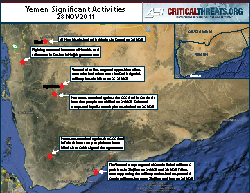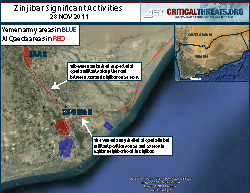 |
The process of transferring power from President Ali Abdullah Saleh began when he signed a transition deal in Riyadh, Saudi Arabia, last week. Though the agreement may begin to address Yemen’s political unrest, armed opposition groups continue to hold power outside of the capital.
President Ali Abdullah Saleh signed the Gulf Cooperation Council (GCC) deal at a ceremony in Riyadh, Saudi Arabia on November 23. The power-transfer deal transitioned power to the vice president and grants Saleh immunity. Vice President Abdul Rab Mansour al Hadi issued a presidential decree setting the date for Yemen’s presidential elections as February 21, 2012. Hadi also named Mohammed Salam Basendwah, an independent who has previously served as Yemen’s foreign and information minister, as the new Prime Minister. Saleh declared a general amnesty for participants in events over the past ten months, except for those who participated in the June 3 attack on the presidential mosque. It is unclear whether the declaration holds any weight; Saleh transferred all authorities to Hadi under the GCC deal.
Yemeni protesters rejected the terms of the GCC deal, which had an immunity clause for Saleh. Thousands of people turned out to demonstrate in major cities across the country including Sana’a and Taiz. Defected First Armored Division troops clashed with Central Security Forces in Sana’a on November 25. Two soldiers were killed. In Sana’a, gunmen fired on protesters on al Zubayri Street in Sana’a, killing at least five people.
 |
A Yemeni security official reported that Yemeni airstrikes killed over 80 opposition tribesmen in Arhab district of Sana’a over a period of 48 hours. The numbers have not been independently verified. Opposition tribesmen overran the local Republican Guard military base, home to the 63rd brigade, days earlier. South of the capital, witnesses reported that air raids targeted tribal areas in Bani Hushaish district on November 26.
Fighting broke out again in Sa’ada governorate between al Houthi rebels and Salafists. The al Houthi rebels attacked Dar al Hadith Islamist center in Damaj outside of Sa’ada city. Twenty people were killed and 70 others injured, according to a tribal source. Al Houthi spokesman Mohammed Abdul Salam reported that ten al Houthi rebels were killed. An al Houthi leader, Saleh Habra, accused the Yemeni government of supplying arms to the Salafist fighters. A radical Islamist reported that an al Qaeda operative attempted to execute a suicide bombing targeting the al Houthis, but that he was discovered. Fighting between al Houthi rebels and “regime militiamen” took place in Hajjah governorate. At least six regime supporters and between eight and 22 al Houthi rebels were killed
Fighting for control of Abyan governorate is ongoing between al Qaeda-linked militants and the Yemeni military. Yemeni security sources reported that Yemeni army shelling targeting positions in Bajdar and Badhrous neighborhoods of Zinjibar killed 12 al Qaeda-linked militants in Zinjibar, including a Mauritanian, Algerian, Saudi, and two Somalis on November 28. Armed tribesmen ambushed suspected al Qaeda militants along the road between Jaar and Zinjibar in Abyan governorate on November 26. Four militants were killed, including an Iraqi. Residents of Zinjibar also reported that a man accused of rape had his right hand publicly amputated. Army shelling on November 24 reportedly killed at least 13 al Qaeda-linked militants in Bajdar neighborhood, including a Saudi, Egyptian, and Bahraini.
← Previous |
Next → |
